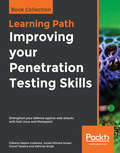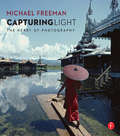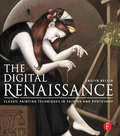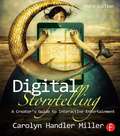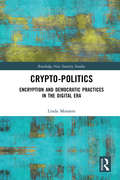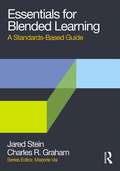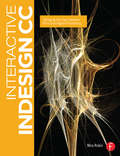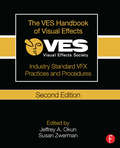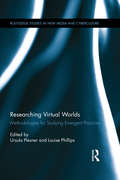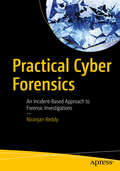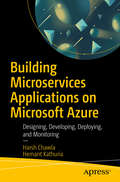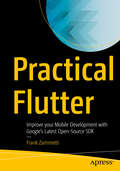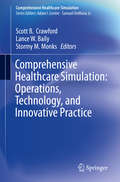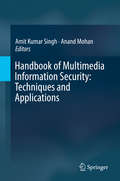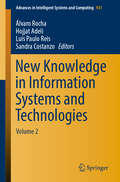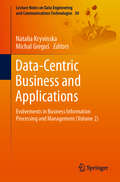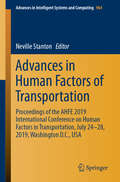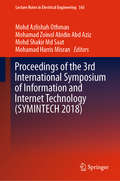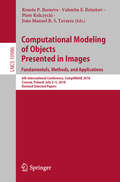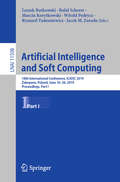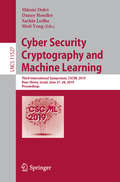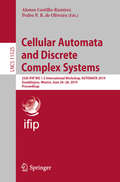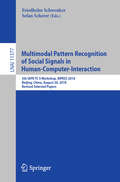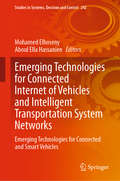- Table View
- List View
Improving your Penetration Testing Skills: Strengthen your defense against web attacks with Kali Linux and Metasploit
by Gilberto Najera-Gutierrez Juned Ahmed Ansari Daniel Teixeira Abhinav SinghEvade antiviruses and bypass firewalls with the most widely used penetration testing frameworks Key Features Gain insights into the latest antivirus evasion techniques Set up a complete pentesting environment using Metasploit and virtual machines Discover a variety of tools and techniques that can be used with Kali Linux Book Description Penetration testing or ethical hacking is a legal and foolproof way to identify vulnerabilities in your system. With thorough penetration testing, you can secure your system against the majority of threats. This Learning Path starts with an in-depth explanation of what hacking and penetration testing is. You'll gain a deep understanding of classical SQL and command injection flaws, and discover ways to exploit these flaws to secure your system. You'll also learn how to create and customize payloads to evade antivirus software and bypass an organization's defenses. Whether it's exploiting server vulnerabilities and attacking client systems, or compromising mobile phones and installing backdoors, this Learning Path will guide you through all this and more to improve your defense against online attacks. By the end of this Learning Path, you'll have the knowledge and skills you need to invade a system and identify all its vulnerabilities. This Learning Path includes content from the following Packt products: Web Penetration Testing with Kali Linux - Third Edition by Juned Ahmed Ansari and Gilberto Najera-Gutierrez Metasploit Penetration Testing Cookbook - Third Edition by Abhinav Singh , Monika Agarwal, et al What you will learn Build and analyze Metasploit modules in Ruby Integrate Metasploit with other penetration testing tools Use server-side attacks to detect vulnerabilities in web servers and their applications Explore automated attacks such as fuzzing web applications Identify the difference between hacking a web application and network hacking Deploy Metasploit with the Penetration Testing Execution Standard (PTES) Use MSFvenom to generate payloads and backdoor files, and create shellcode Who this book is for This Learning Path is designed for security professionals, web programmers, and pentesters who want to learn vulnerability exploitation and make the most of the Metasploit framework. Some understanding of penetration testing and Metasploit is required, but basic system administration skills and the ability to read code are a must.
Monochromatic HDR Photography: Shooting And Processing Black And White High Dynamic Range Photos
by Harold DavisUpdate: The Kindle version of Monochromatic HDR Photography: Shooting and Processing Black & White High Dynamic Range Photos currently available for sale has been corrected and updated to address formatting issues. Monochromatic HDR Photography is the first book intended to show photographers how to work at the intersection of two up-and-coming trends that are at the forefront of the digital revolution: Black & White and High Dynamic Range imaging. The book explains techniques for extending dynamic range, monochromatic conversion methods and best practices where the two technologies intersect. Since successful digital monochromatic image creation generally requires using the color information inherent in RAW exposures, most case studies will be presented in full color. In addition, Monochromatic HDR Photography provides extensive coverage of the creative vision required to successfully create monochromatic HDR images and the workflow necessary to make art prints from this specialized image making technique.
Capturing Light: The Heart of Photography
by Michael FreemanIn almost all photography it’s the quality of light that makes or breaks the shot. For professional photographers, chasing the light, waiting for it, sometimes helping it, and finally capturing it is a constant preoccupation — and for some an obsession. Drawing on four decades of doing just this, Michael Freeman takes a simple but practical approach to reacting to, and capturing photography’s most important commodity. There are just three sections titled Waiting, Chasing, and Helping: Waiting explains the kinds of lighting that photographers can anticipate and plan for, while Chasing explores the transient, serendipitous light that photographers have to work quickly to exploit. Helping, the final and most technical section, focuses on the skills and techniques for enhancing, reducing, or otherwise controlling light, covering everything from in-the-field shooting choices to technical transformations to post-production.
The Digital Renaissance: Classic Painting Techniques in Photoshop and Painter
by Carlyn BecciaPlease note: the website printed in the book [carlynpaints.com] is no longer valid. Please find the author's dedicated book page at: http://www.carlynbeccia.com/carlynpaints/thedigitalrenaissance.html Also, the excercise downloads referred to in the book at: http://www.carlynbeccia.com/carlynpaints/downloads.html The Digital Renaissance teaches you how to translate the methods and skills found in traditional art to the digital medium. By covering fundamental painting principles and the basics of digital software, before moving into tutorials that break down key techniques, professional artist Carlyn Beccia teaches you how to use the tools at hand to paint your own works of art. Each chapter showcases one great painter and analyzes the techniques that set each one apart. These techniques are then imitated in step-by-step tutorials, allowing you to achieve amazingly convincing results and bring your own work to new creative heights.
Digital Storytelling: A creator's guide to interactive entertainment
by Carolyn Handler MillerDigital Storytelling shows you how to create immersive, interactive narratives across a multitude of platforms, devices, and media. From age-old storytelling techniques to cutting-edge development processes, this book covers creating stories for all forms of New Media, including transmedia storytelling, video games, mobile apps, and second screen experiences. The way a story is told, a message is delivered, or a narrative is navigated has changed dramatically over the last few years. Stories are told through video games, interactive books, and social media. Stories are told on all sorts of different platforms and through all sorts of different devices. They’re immersive, letting the user interact with the story and letting the user enter the story and shape it themselves. This book features case studies that cover a great spectrum of platforms and different story genres. It also shows you how to plan processes for developing interactive narratives for all forms of entertainment and non-fiction purposes: education, training, information and promotion. Digital Storytelling features interviews with some of the industry’s biggest names, showing you how they build and tell their stories.
Crypto-Politics: Encryption and Democratic Practices in the Digital Era (Routledge New Security Studies)
by Linda MonseesThis book examines current debates about the politics of technology and the future of democratic practices in the digital era. The volume centres on the debates on digital encryption in Germany and the USA, during the aftermath of Edward Snowden’s leaks, which revolved around the value of privacy and the legitimacy of surveillance practices. Using a discourse analysis of mass media and specialist debates, it shows how these are closely interlinked with technological controversies and how, as a result, contestation emerges not within one public sphere but within multiple expert circles. The book develops the notion of ‘publicness’ in order to grasp the political significance of these controversies, thereby making an innovative contribution to Critical Security Studies by introducing digital encryption as an important site for understanding the broader debates on cyber security and surveillance. This book will be of much interest to students of critical security studies, science and technology studies, and International Relations.
Essentials for Blended Learning: A Standards-Based Guide (Essentials of Online Learning)
by Jared Stein Charles R. GrahamEssentials for Blended Learning: A Standards-Based Guide provides a practical, streamlined approach for creating effective learning experiences by blending online activities and the best of face-to-face teaching. This guide is: Easy to use: Clear, jargon-free writing; illustrations; and references to online resources help readers understand concepts. Streamlined: A simple but effective design process focuses on creating manageable activities for the right environment. Practical: Real-world examples from different subject areas help teachers understand principles in context. Contemporary: The variety of modern, connected technologies covered in the guide addresses a range of teaching challenges. Forward-Looking: The approach bridges the gap between formal classroom learning and informal lifelong learning. Standards-based: Guidelines and standards are based on current research in the field, relevant learning theories, and practitioner experiences. Effective blended learning requires significant rethinking of teaching practices and a fundamental redesign of course structure. Essentials for Blended Learning: A Standards-Based Guide simplifies these difficult challenges without neglecting important opportunities to transform teaching. This guide is suitable for teachers in any content area. Please visit www.essentialsforblended.com for additional resources.
Interactive InDesign CC: Bridging the Gap between Print and Digital Publishing
by Mira RubinWith a growing focus on digital destinations, the publishing landscape is evolving at a dizzying speed and InDesign CC is at the forefront of the digital frontier. Known as the premiere layout application for magazine and print collateral, InDesign is also a powerful creation tool for both static and interactive PDF, Flash SWF, EPUB, and apps that can be published for sale in various app stores. This tutorial-based guide to InDesign CC provides you with a hands-on experience of the EPUB creation process, InDesign animation, Digital Publishing Suite app creation, creation of interactive PDFs, and a host of techniques that serve equally well in both print and digital production. This extensively detailed book is filled with over 700 screenshots, explicit diagrams, and step-by-step real-world exercises to get you up and running with: *InDesign Animation *Buttons, forms, and other interactive elements *Interactive PDFs *EPUB *App building with DPS *The fundamentals of HTML, CSS, and GREP *A treasure trove of trips and techniques that will forever transform your work with InDesign.
The VES Handbook of Visual Effects: Industry Standard VFX Practices and Procedures
by Jeffrey A. Okun Susan ZwermanWisdom from the best and the brightest in the industry, this visual effects bible belongs on the shelf of anyone working in or aspiring to work in VFX. The book covers techniques and solutions all VFX artists/producers/supervisors need to know, from breaking down a script and initial bidding, to digital character creation and compositing of both live-action and CG elements. In-depth lessons on stereoscopic moviemaking, color management and digital intermediates are included, as well as chapters on interactive games and full animation authored by artists from EA and Dreamworks respectively. From predproduction to acquisition to postproduction, every aspect of the VFX production workflow is given prominent coverage. VFX legends such as John Knoll, Mike Fink, and John Erland provide you with invaluable insight and lessons from the set, equipping you with everything you need to know about the entire visual effects workflow. Simply a must-have book for anyone working in or wanting to work in the VFX industry.
Researching Virtual Worlds: Methodologies for Studying Emergent Practices (Routledge Studies in New Media and Cyberculture)
by Ursula Plesner Louise PhillipsThis volume presents a wide range of methodological strategies that are designed to take into account the complex, emergent, and continually shifting character of virtual worlds. It interrogates how virtual worlds emerge as objects of study through the development and application of various methodological strategies. Virtual worlds are not considered objects that exist as entities with fixed attributes independent of our continuous engagement with them and interpretation of them. Instead, they are conceived of as complex ensembles of technology, humans, symbols, discourses, and economic structures, ensembles that emerge in ongoing practices and specific situations. A broad spectrum of perspectives and methodologies is presented: Actor-Network-Theory and post-Actor-Network-Theory, performativity theory, ethnography, discourse analysis, Sense-Making Methodology, visual ethnography, multi-sited ethnography, and Social Network Analysis.
Practical Cyber Forensics: An Incident-Based Approach to Forensic Investigations
by Niranjan ReddyBecome an effective cyber forensics investigator and gain a collection of practical, efficient techniques to get the job done. Diving straight into a discussion of anti-forensic techniques, this book shows you the many ways to effectively detect them. Now that you know what you are looking for, you’ll shift your focus to network forensics, where you cover the various tools available to make your network forensics process less complicated. Following this, you will work with cloud and mobile forensic techniques by considering the concept of forensics as a service (FaSS), giving you cutting-edge skills that will future-proof your career.Building on this, you will learn the process of breaking down malware attacks, web attacks, and email scams with case studies to give you a clearer view of the techniques to be followed. Another tricky technique is SSD forensics, so the author covers this in detail to give you the alternative analysis techniques you’ll need. To keep you up to speed on contemporary forensics, Practical Cyber Forensics includes a chapter on Bitcoin forensics, where key crypto-currency forensic techniques will be shared. Finally, you will see how to prepare accurate investigative reports. What You Will LearnCarry out forensic investigation on Windows, Linux, and macOS systemsDetect and counter anti-forensic techniques Deploy network, cloud, and mobile forensicsInvestigate web and malware attacksWrite efficient investigative reportsWho This Book Is ForIntermediate infosec professionals looking for a practical approach to investigative cyber forensics techniques.
Building Microservices Applications on Microsoft Azure: Designing, Developing, Deploying, and Monitoring
by Harsh Chawla Hemant KathuriaImplement microservices starting with their architecture and moving on to their deployment, manageability, security, and monitoring. This book focuses on the key scenarios where microservices architecture is preferred over a monolithic architecture.Building Microservices Applications on Microsoft Azure begins with a survey of microservices architecture compared to monolithic architecture and covers microservices implementation in detail. You'll see the key scenarios where microservices architecture is preferred over a monolithic approach. From there, you will explore the critical components and various deployment options of microservices on platforms such as Microsoft Azure (public cloud) and Azure Stack (hybrid cloud). This includes in-depth coverage of developing, deploying, and monitoring microservices on containers and orchestrating with Azure Service Fabric and Azure Kubernetes Cluster (AKS).This book includes practical experience from large-scale enterprise deployments, therefore it can be a quick reference for solution architects and developers to understand the critical factors while designing a microservices application. What You Will LearnExplore the use cases of microservices and monolithic architectureDiscover the architecture patterns to build scalable, agile, and secure microservices applicationsDevelop and deploy microservices using Azure Service Fabric and Azure Kubernetes Service Secure microservices using the gateway patternSee the deployment options for Microservices on Azure StackImplement database patterns to handle the complexities introduced by microservices Who This Book Is ForArchitects and consultants who work on Microsoft Azure and manage large-scale deployments.
Practical Flutter: Improve your Mobile Development with Google’s Latest Open-Source SDK
by Frank ZammettiExplore what Flutter has to offer, where it came from, and where it’s going. Mobile development is progressing at a fast rate and with Flutter – an open-source mobile application development SDK created by Google – you can develop applications for Android and iOS, as well as Google Fuchsia.Learn to create three apps (a personal information manager, a chat system, and a game project) that you can install on your mobile devices and use for real. You will begin by getting a solid foundation of Flutter knowledge, and building on it immediately by constructing two more traditional productivity apps.. You will also learn to create a game, enabling you to see a whole other perspective on what Flutter can do. In addition to building these apps, you'll have the benefit of reviewing real-world issues you might encounter, along with ways to deal with them through tips and tricks, all designed to make your Flutter experience that much more productive and, frankly, fun!Practical Flutter will leave you with a solid grasp of how to build apps with Flutter, and springboard into creating more advanced apps on your own. By the time your journey through this material concludes, another larger one will begin as you springboard, well-prepared, into the larger world of Flutter development, tackling any project that comes your way with aplomb. Practical Flutter is a learning adventure you won't want to miss.What You'll LearnGet a Flutter project started and logically structure itUse the interface elements Flutter provides, such as widgets, controls, and extensionsBuild layouts using interface elementsUse available tooling, specifically Android StudioLeverage server-side development and connect a Flutter app to a server back-end. Who This Book Is ForMobile developers who are looking to build for multiple mobile platforms and trying to do so with a codebase that is largely the same across all. Basic knowledge of iOS and Android generally, and some general programming experience is expected.
Comprehensive Healthcare Simulation: Operations, Technology, and Innovative Practice (Comprehensive Healthcare Simulation)
by Scott B. Crawford Lance W. Baily Stormy M. MonksThis practical guide provides a focus on the implementation of healthcare simulation operations, as well as the type of professional staff required for developing effective programs in this field. Though there is no single avenue in which a person pursues the career of a healthcare simulation technology specialist (HSTS), this book outlines the extensive knowledge and variety of skills one must cultivate to be effective in this role. This book begins with an introduction to healthcare simulation, including personnel, curriculum, and physical space. Subsequent chapters address eight knowledge/skill domains core to the essential aspects of an HSTS. To conclude, best practices and innovations are provided, and the benefits of developing a collaborative relationship with industry stakeholders are discussed. Expertly written text throughout the book is supplemented with dozens of high-quality color illustrations, photographs, and tables. Written and edited by leaders in the field, Comprehensive Healthcare Simulation: Operations, Technology, and Innovative Practice is optimized for a variety of learners, including healthcare educators, simulation directors, as well as those looking to pursue a career in simulation operations as healthcare simulation technology specialists.
Handbook of Multimedia Information Security: Techniques and Applications
by Amit Kumar Singh Anand MohanThis handbook is organized under three major parts. The first part of this handbook deals with multimedia security for emerging applications. The chapters include basic concepts of multimedia tools and applications, biological and behavioral biometrics, effective multimedia encryption and secure watermarking techniques for emerging applications, an adaptive face identification approach for android mobile devices, and multimedia using chaotic and perceptual hashing function. The second part of this handbook focuses on multimedia processing for various potential applications. The chapter includes a detail survey of image processing based automated glaucoma detection techniques and role of de-noising, recent study of dictionary learning based image reconstruction techniques for analyzing the big medical data, brief introduction of quantum image processing and it applications, a segmentation-less efficient Alzheimer detection approach, object recognition, image enhancements and de-noising techniques for emerging applications, improved performance of image compression approach, and automated detection of eye related diseases using digital image processing. The third part of this handbook introduces multimedia applications. The chapter includes the extensive survey on the role of multimedia in medicine and multimedia forensics classification, a finger based authentication system for e-health security, analysis of recently developed deep learning techniques for emotion and activity recognition. Further, the book introduce a case study on change of ECG according to time for user identification, role of multimedia in big data, cloud computing, the Internet of things (IoT) and blockchain environment in detail for real life applications. This handbook targets researchers, policy makers, programmers and industry professionals in creating new knowledge for developing efficient techniques/framework for multimedia applications. Advanced level students studying computer science, specifically security and multimedia will find this book useful as a reference.
New Knowledge in Information Systems and Technologies: Volume 2 (Advances in Intelligent Systems and Computing #931)
by Hojjat Adeli Álvaro Rocha Luís Paulo Reis Sandra CostanzoThis book includes a selection of articles from The 2019 World Conference on Information Systems and Technologies (WorldCIST’19), held from April 16 to 19, at La Toja, Spain.WorldCIST is a global forum for researchers and practitioners to present and discuss recent results and innovations, current trends, professional experiences and challenges in modern information systems and technologies research, together with their technological development and applications.The book covers a number of topics, including A) Information and Knowledge Management; B) Organizational Models and Information Systems; C) Software and Systems Modeling; D) Software Systems, Architectures, Applications and Tools; E) Multimedia Systems and Applications; F) Computer Networks, Mobility and Pervasive Systems; G) Intelligent and Decision Support Systems; H) Big Data Analytics and Applications; I) Human–Computer Interaction; J) Ethics, Computers & Security; K) Health Informatics; L) Information Technologies in Education; M) Information Technologies in Radiocommunications; and N) Technologies for Biomedical Applications.
Data-Centric Business and Applications: Evolvements in Business Information Processing and Management (Volume 2) (Lecture Notes on Data Engineering and Communications Technologies #30)
by Natalia Kryvinska Michal GregušThis book explores various aspects of data engineering and information processing. In this second volume, the authors assess the challenges and opportunities involved in doing business with information. Their contributions on business information processing and management reflect diverse viewpoints – not only technological, but also business and social. As the global marketplace grows more and more complex due to the increasing availability of data, the information business is steadily gaining popularity and has a huge impact on modern society. Thus, there is a growing need for consensus on how business information can be created, accessed, used and managed.
Advances in Human Factors of Transportation: Proceedings of the AHFE 2019 International Conference on Human Factors in Transportation, July 24-28, 2019, Washington D.C., USA (Advances in Intelligent Systems and Computing #964)
by Neville StantonThis book discusses the latest advances in research and development, design, operation and analysis of transportation systems and their complementary infrastructures. It reports on both theories and case studies on road and rail, aviation and maritime transportation. Further, it covers a wealth of topics, from accident analysis, vehicle intelligent control, and human-error and safety issues to next-generation transportation systems, model-based design methods, simulation and training techniques, and many more. A special emphasis is placed on smart technologies and automation in transport, and on the user-centered, ergonomic and sustainable design of transport systems. The book, which is based on the AHFE 2019 International Conference on Human Factors in Transportation, held on July 24-28, 2019, in Washington D.C., USA, mainly addresses the needs of transportation system designers, industrial designers, human–computer interaction researchers, civil and control engineers, as well as vehicle system engineers. Moreover, it represents a timely source of information for transportation policy-makers and social scientists whose work involves traffic safety, management, and sustainability issues in transport.
Proceedings of the 3rd International Symposium of Information and Internet Technology (Lecture Notes in Electrical Engineering #565)
by Mohd Azlishah Othman Mohamad Zoinol Abd Aziz Mohd Shakir Md Saat Mohamad Harris MisranThis book gathers the proceedings of a symposium on the role of Internet technologies and how they can transform and improve people’s lives. The Internet is essentially a massive database where all types of information can be shared and transmitted. This can be done passively in the form of non-interactive websites and blogs; or it can be done actively in the form of file sharing and document up- and downloading. Thanks to these technologies, a wealth of information is now available to anyone who can access the Internet. Moreover, Internet technologies are constantly improving: growing faster, offering more diverse information, and supporting processes that would have been impossible in the past. As a result, they have changed, and will continue to change, the way that the world does business and how people interact in their day-to-day lives. In conclusion, the symposium and these proceedings provide a valuable opportunity for leading researchers, engineers and professionals around the globe to discuss the latest advances that are helping the world move forward. They also facilitate the exchange of new ideas in the fields of communication technology to create a dialogue between these groups concerning the latest innovations, trends and concerns, practical challenges and potential solutions in the field of Internet technologies.
Computational Modeling of Objects Presented in Images. Fundamentals, Methods, and Applications: 6th International Conference, CompIMAGE 2018, Cracow, Poland, July 2–5, 2018, Revised Selected Papers (Lecture Notes in Computer Science #10986)
by Reneta P. Barneva Valentin E. Brimkov Piotr Kulczycki João Manuel TavaresThis book constitutes the refereed post-conference proceedings of the 6th International Symposium on Computational Modeling of Objects Presented in Images, CompIMAGE 2018, held in Cracow, Poland, inJuly 2018.The 16 revised full papers presented in this book were carefully reviewed and selected from 30 submissions. The papers cover the following topics: digital geometry; digital tomography; and methods and applications.
Artificial Intelligence and Soft Computing: 18th International Conference, ICAISC 2019, Zakopane, Poland, June 16–20, 2019, Proceedings, Part I (Lecture Notes in Computer Science #11508)
by Leszek Rutkowski Rafał Scherer Marcin Korytkowski Witold Pedrycz Ryszard Tadeusiewicz Jacek M. ZuradaThe two-volume set LNCS 11508 and 11509 constitutes the refereed proceedings of of the 18th International Conference on Artificial Intelligence and Soft Computing, ICAISC 2019, held in Zakopane, Poland, in June 2019. The 122 revised full papers presented were carefully reviewed and selected from 333 submissions. The papers included in the first volume are organized in the following five parts: neural networks and their applications; fuzzy systems and their applications; evolutionary algorithms and their applications; pattern classification; artificial intelligence in modeling and simulation. The papers included in the second volume are organized in the following five parts: computer vision, image and speech analysis; bioinformatics, biometrics, and medical applications; data mining; various problems of artificial intelligence; agent systems, robotics and control.
Cyber Security Cryptography and Machine Learning: Third International Symposium, CSCML 2019, Beer-Sheva, Israel, June 27–28, 2019, Proceedings (Lecture Notes in Computer Science #11527)
by Shlomi Dolev Danny Hendler Sachin Lodha Moti YungThis book constitutes the refereed proceedings of the Third International Symposium on Cyber Security Cryptography and Machine Learning, CSCML 2019, held in Beer-Sheva, Israel, in June 2019.The 18 full and 10 short papers presented in this volume were carefully reviewed and selected from 36 submissions. They deal with the theory, design, analysis, implementation, or application of cyber security, cryptography and machine learning systems and networks, and conceptually innovative topics in these research areas.
Cellular Automata and Discrete Complex Systems: 25th IFIP WG 1.5 International Workshop, AUTOMATA 2019, Guadalajara, Mexico, June 26–28, 2019, Proceedings (Lecture Notes in Computer Science #11525)
by Alonso Castillo-Ramirez Pedro P. B. de OliveiraThis volume constitutes the refereed proceedings of the 25th IFIP WG 1.5 International Workshop on Cellular Automata and Discrete Complex Systems, AUTOMATA 2019, held in Guadalajara, Mexico, in June 2019.The 7 regular papers presented in this book were carefully reviewed and selected from a total of 10 submissions. The topics of the conference include deal with dynamical, topological, ergodic and algebraic aspects of CA and DCS, algorithmic and complexity issues, emergent properties, formal languages, symbolic dynamics, tilings, models of parallelism and distributed systems, timing schemes, synchronous versus asynchronous models, phenomenological descriptions, scientic modeling, and practical applications.
Multimodal Pattern Recognition of Social Signals in Human-Computer-Interaction: 5th IAPR TC 9 Workshop, MPRSS 2018, Beijing, China, August 20, 2018, Revised Selected Papers (Lecture Notes in Computer Science #11377)
by Friedhelm Schwenker Stefan SchererThis book constitutes the refereed post-workshop proceedings of the 5th IAPR TC9 Workshop on Pattern Recognition of Social Signals in Human-Computer-Interaction, MPRSS 2018, held in Beijing, China, in August 2018. The 10 revised papers presented in this book focus on pattern recognition, machine learning and information fusion methods with applications in social signal processing, including multimodal emotion recognition and pain intensity estimation, especially the question how to distinguish between human emotions from pain or stress induced by pain is discussed.
Emerging Technologies for Connected Internet of Vehicles and Intelligent Transportation System Networks: Emerging Technologies for Connected and Smart Vehicles (Studies in Systems, Decision and Control #242)
by Mohamed Elhoseny Aboul Ella HassanienThis book discusses vehicular communication systems, IoT, intelligent transportation systems and the Internet of Vehicles, and also introduces destination marketing in a structured manner. It is primarily intended for research students interested in emerging technologies for connected Internet of Vehicles and intelligent transportation system networks; academics in higher education institutions, including universities and vocational colleges; IT professionals; policy makers; and legislators. The book can also be used as a reference resource for both undergraduate and graduate studies. Written in plain and simple language, it describes new concepts so that they are accessible to readers without prior knowledge of the field.
